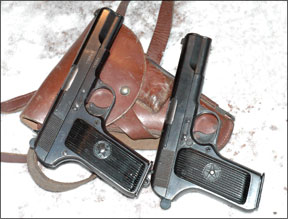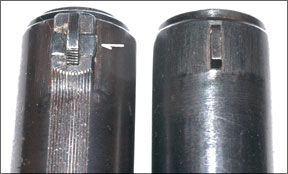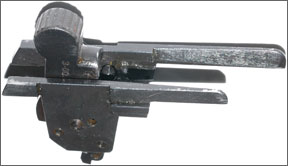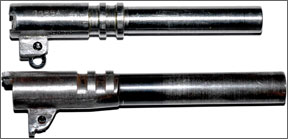The Tokarev pistol replaced the old Nagant revolver in Russia in the 1930s, and what a change it was. The new semiauto zinged out an 85-grain bullet at close to 1500 fps, and was the speed king for handguns until the advent of the 357 Magnum in the 1950s, which could sometimes equal, but seldom exceed, the speed of the Mauser-designed cartridge.

The 7.62x25mm Tokarev cartridge originated before the turn of the 19th century as the 30 Borchardt, which didn’t quite make the velocity of the Mauser or Tokarev cartridges, though the bullet weight was the same. It then was adopted by Mauser and was loaded hotter for his Broomhandle. The Russians copied the 1896 Mauser round essentially exactly, but put it into a much simpler handgun. While somewhat similar to the Colt 1911 design, the Tokarev was a simplification in some ways, and an advancement in others. The big thing about the Tokarev is the original design of both the TT-30 and TT-33 lacked a safety. There was a half-cock position on the hammer, but no easy way to lower the hammer once it was cocked, nor to keep it in the cocked position.
We acquired two Tokarev TT-33 variants for this test report. One was a Yugoslavian version, marked as the Model M57. It featured a well-made and cleanly installed thumb safety that permitted normal and confident cocked-and-locked carry. The other gun was from Romania and had a crude safety that had been added to permit importation into the U.S. There were other slight differences between the two that we’ll get into later.
Because the takedown is identical for the two, we’ll discuss that first. One of the nicer aspects of the Tokarev is a much easier takedown than that of the 1911. You don’t have to wrestle the slide all the way back and hunt for a notch to get the cross pin out. And once the slide is removed toward the front, the hammer/sear group comes out as a unit for easy cleaning or replacement. The slide spring remains in the gun until you pull it out, which then permits removal of the barrel.
The Tokarev was a clean design, we thought, with an easily cocked hammer and excellent sights, though the rear one was on the high side to properly match the front blade. None of our shooters disliked the vertical grip angle of these two pistols. We all thought the grip felt natural.
The Tokarev has a barrel bushing, but turning it is not required to remove the slide. The slide spring keeps the barrel bushing in place, and once the slide spring is removed, the barrel bushing can be rotated 180 degrees to free the barrel, which comes out of the gun toward the front.
The barrels of the two guns had locking rings machined completely around their circumferences, though only the top portion locked into the slide. The benefit is much easier manufacture than that needed for a typical 1911 barrel.
Both guns exhibited a semi-gloss blued finish, and both had plastic grips that were held in place by hidden clips, accessible via the mag well. Both had lanyard rings, and both had fixed sights. The handling differences between the two were minimal, and the range results were similar. The Romanian version had a shorter grip, permitting eight rounds in the magazine instead of nine for the Yugo version. We tested them with two types of low-cost surplus ammunition, Romanian and Polish. Here’s what we found.

Yugoslav M57 7.62x25mm Tokarev, about $250
The gun was originally imported by PW Arms and was so marked, but was sold by Southern Ohio Gun. We don’t know if they have any more as of this writing, but that can change quickly. It arrived filled with a sticky type of preservative grease, which we removed with paper towels after heating the gun parts on top of a wood stove. As we found out later, that was inadequate. The cleaning effort mandated a fairly full teardown, and we were pleasantly surprised at what we found inside, already discussed somewhat above. We thought it prudent to remove this gun’s firing pin, which was not the easiest task. Like that of a 1911-type auto, the pin had to be pressed forward and then a keeper needed to be pulled down out of a slot, releasing the firing pin toward the rear. The pin was composed of four parts, two coil springs, the pin itself, and a bushing that circled the pin at the back. After removal of the grease we had a hard time replacing the firing pin. The sliding keeper could not be used to partly hold the guts in place like on a 1911. This type firing pin is unique to the Yugo version of the T33. The other gun had the original Soviet design, which was a notched pin held in place by a cross pin through the slide. Also, the M57 could not be fired with the magazine removed, unlike the other gun.
You’ll note the slide spring has to bend to come out, but the Model 57 has a full-length steel guide rod that would normally prevent any bending. The solution was to make the guide rod articulated, so the otherwise rigid shaft can bend enough to permit the removal of the captive spring assembly.
The fit of the hammer assembly in the slide was on the loose side, we thought. The gun was crisp everywhere, with minimal scratches or signs of wear. We thought this one was going to be top dog in this test because of the overall very good looks of the gun and all of its parts. Boy, were we wrong…at first.
On the range we loaded up a full complement of 9+1 rounds and fired the first shot. We had a failure to feed, not a major problem because of some remaining traces of stiff grease and an outside temperature around 15 degrees. We had no more failures to feed. The first group looked pretty good, so we progressed with our shooting, and then the troubles began. The trigger pull began to get harder and harder. We finished with the first ammo type and tried the next, and then had our first experience with a release trigger on a handgun.
We pressed hard, but the gun would not fire. We eased up on our trigger pull, with a thought to find out what might be wrong, and as we relaxed our trigger finger the gun fired. We tried it again, and again it would not fire no matter how hard we pulled, but as we released the trigger the gun again fired. The problem was not consistent. Sometimes the gun fired normally, and sometimes it would not fire at all. Eventually we got our testing done, though several times, now knowing what to expect, we held our sight picture carefully as we released the trigger, and then got the shot. Despite this trouble, the gun looked to be fairly accurate.

Clearly we would not recommend such a faulty and potentially dangerous handgun, even though we liked this Tokarev, and it was trying hard to shoot extremely well. In fact we once had four out of the five shots into less than an inch at 15 yards. Before we condemned the gun and gave it a failing grade, we carefully examined the disconnector mechanism. This consisted of a plunger that pressed down on the trigger bow, causing it to clear the sear until the gun was again in battery with the hammer back. Releasing the trigger should have permitted the trigger bow to rise into position to bear against the sear again. In the disconnector we found the trouble. There was a bit of grease remaining that, in the extremely cold weather, froze and caused the trigger bow to stick slightly in the downward position, which led to the odd-firing scenario. The sear was somehow tripped, but the hammer apparently was held by the trigger until we slacked off pressure on it, which then permitted the hammer to fly forward.
Our solution was to soak the various parts overnight in solvent, and then carefully lubricate the entire thing with good light oil. This gave us a perfectly clean gun, and to our joy, perfect function. The trigger now fired the gun every time with no problems.
Our Team Said: We had no option but to give this M57 Tokarev an A grade. We liked the sight picture, the condition, the overall quality of the gun and its manufacture, the quality of the bluing, the grip shape and feel, the balance, the safety setup, and especially the price. We hope you learn from our mistakes. If you buy a gun loaded with Cosmoline or other form of preservative grease, be sure to get it all out of the gun before you commence shooting. Anything less can be deadly dangerous.
Romanian T33 7.62x25mm Tokarev, $350 with extras
This one came from Collectors Firearms in Houston along with a nice period leather holster, which held a spare magazine and a cleaning rod. The gun had been “arsenal refurbished,” per the tag on it. There was slight rounding of the slide sides, but overall the gun looked fairly decent, we thought. On disassembly we found some interesting differences between it and the Yugoslavian version. The firing pin was made in the simple original Soviet design, and the slide spring did not have a full-length guide rod. Therefore when the slide came off the frame, the spring was easily removed. The trigger group was tight in the frame, and had to be pried out, unlike the other gun in which it fell out. The friction here was from one small cross pin, which was a touch too long.

After a few rounds of test firing we could not get the barrel out of the slide easily. The groove in the slide through which the barrel lug had to exit appeared to be so tight it didn’t permit the barrel to come out. We had noticed the recoil spring was noticeably weaker in this Romanian gun, and on inspection found that the rear edges of the slide just above the opening for the barrel lug had been battered, peened over, resulting in a blocked slot. We were able to work the barrel out and then filed these battered edges away so the gun could be properly disassembled. One of the two magazines was assembled incorrectly, and was full of gritty, rusty flakes.
The add-on safety was crudely made, and we found it interfered with the removal of the split retainer for the slide pin. The safety simply blocked the trigger. It worked properly, and could be operated easily with the right thumb. As such, it permitted cocked-and-locked carry. For some reason the right plastic grip panel did not come down to the bottom of the frame.
Like the Yugo version, this Romanian one had a simple driftable rear sight set into a crosswise notch in the slide, but the front blade was brazed or silver soldered on, and the slide had filing marks next to the front blade. By contrast, the Yugo had its front sight dovetailed into a small ramp, very modern and far better from a maintenance viewpoint. The top of the Romanian’s slide was smooth, but the Yugoslav version had serrations leading from the ejection port up to the front sight.
On the range the Romanian gun performed reliably, with accuracy close to that of the Yugo. We shot it rapid fire and found it was very easy to get double taps into one hole. We found the recoil of these hot cartridges in these handguns to be not very significant. The report was sharp with a bit of muzzle flash. We thought it was, all in all, a pleasant experience shooting them. This Romanian gun struck about 3.5 inches above the point of aim at 15 yards. The other one hit where it looked.
Our Team Said: We didn’t like the crude look of its safety, the rounded-over edges to the various components from refinishing, the battering of the slide from the too-weak recoil spring, the too-short grip panel, and the partially blocked spring clip that held the cross pin in place. We also didn’t like the fact that it shot high, and there was no way of fixing that short of filing down the rear sight. Of these two curio & relic guns, we thought the Yugoslavian version was a whole lot nicer pistol for a lot less money.





























